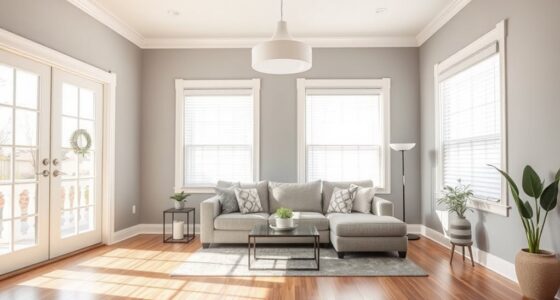Proper bedroom ventilation is key to better sleep, healthier air, and comfort. You should maximize natural airflow by opening windows opposite each other and keeping interior doors open. Use exhaust fans in humid areas and consider air purifiers for extra freshness. Maintain humidity levels between 40-60% and choose the right ventilation devices for your space. Avoid blocking vents or sealing windows—small adjustments can make a big difference. Discover more tips to transform your bedroom environment.
Key Takeaways
- Maximize natural cross-ventilation by opening windows on opposite sides and avoiding obstructions for steady airflow.
- Use appropriate ventilation devices like exhaust fans or air purifiers based on room size and needs.
- Keep interior doors open during the day to enhance airflow and prevent stale air buildup.
- Maintain balanced humidity levels (40-60%) with humidifiers or dehumidifiers, monitored by a hygrometer.
- Regularly clean and check vents, fans, and filters to ensure optimal air quality and ventilation efficiency.
The Importance of Fresh Air Circulation in Your Bedroom
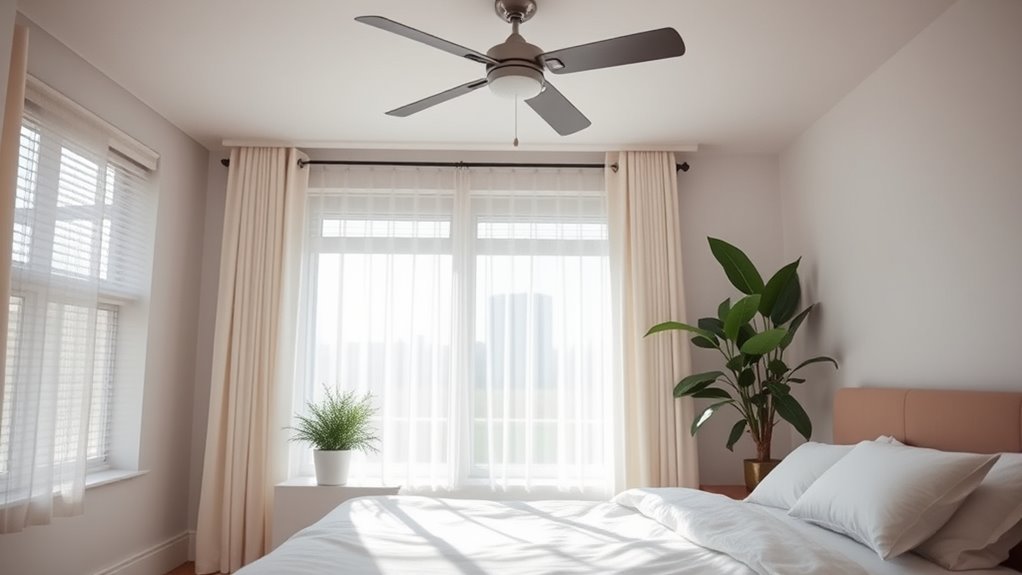
Good air circulation is essential for a healthy and comfortable bedroom environment. When fresh air flows in, it improves air quality by reducing indoor pollutants, allergens, and humidity. Better air quality directly impacts your sleep quality, helping you fall asleep faster and enjoy deeper rest. Stale air can cause discomfort, stuffiness, and even breathing issues, which disrupt your sleep cycle. By ensuring proper ventilation, you promote a steady exchange of indoor and outdoor air, which refreshes the room continuously. This not only keeps the air clean but also maintains an ideal temperature and humidity level. When your bedroom has good air circulation, you create a healthier space that encourages restful, uninterrupted sleep and supports your overall well-being.
How to Maximize Natural Ventilation Effectively
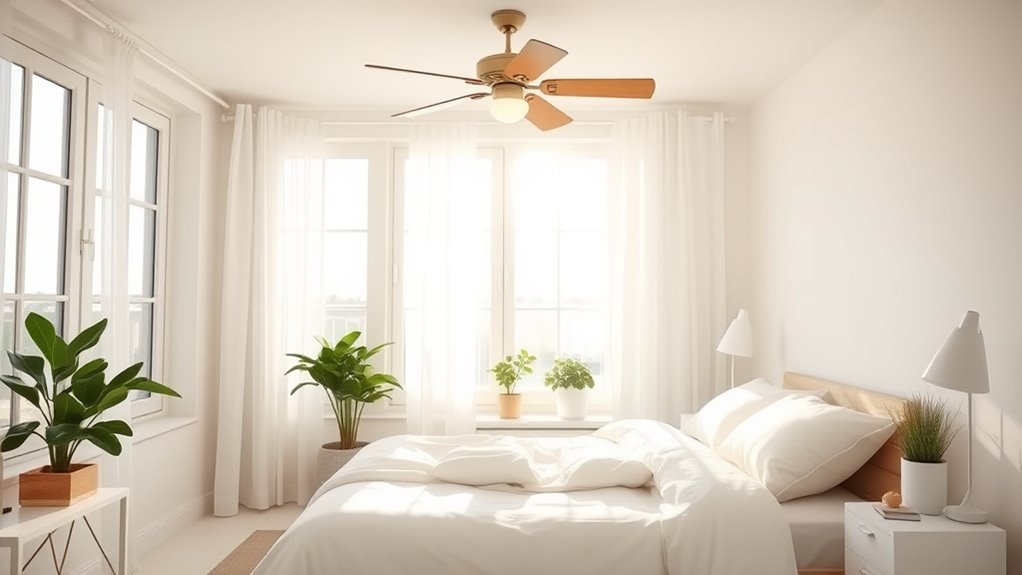
To maximize natural ventilation in your bedroom, start by optimizing window placement to catch prevailing breezes. Use cross-ventilation techniques by opening windows on opposite sides to create a steady airflow. Incorporate ventilation aids like fans or vents to boost circulation when natural airflow is limited.
Optimize Window Placement
Maximizing natural ventilation starts with strategic window placement that encourages effective airflow throughout your bedroom. Proper window orientation ensures you catch prevailing breezes and optimize natural light, making your space more comfortable and energy-efficient. To do this:
- Position windows to face prevailing wind directions, boosting airflow and reducing stagnant air.
- Place windows across from each other to facilitate cross-ventilation, even if you’re not focusing on that technique now.
- Consider natural light when choosing window locations—well-placed windows enhance airflow without sacrificing sunlight.
Use Cross-Ventilation Techniques
Utilizing cross-ventilation is one of the most effective ways to enhance natural airflow in your bedroom. By opening windows on opposite sides, you create airflow patterns that allow fresh air to flow in and stale air to exit, boosting ventilation efficiency. To maximize this, make certain windows are aligned to facilitate a steady breeze, especially during breezy days. Keep obstructions like furniture or heavy curtains away from windows to prevent disrupting airflow patterns. Adjust window openings to control the amount of air entering and exiting, optimizing comfort without causing drafts. Cross-ventilation not only refreshes your space but also helps regulate temperature and humidity levels naturally. Implementing this technique regularly can considerably improve your bedroom’s overall air quality and contribute to a healthier, more comfortable environment.
Incorporate Ventilation Aids
Adding ventilation aids like fans, window vents, or exhaust systems can substantially boost natural airflow in your bedroom. These tools help improve air quality and reduce humidity, making your space more comfortable. To maximize their effectiveness, consider these options:
- Install quiet fans or exhaust vents to enhance airflow without adding noise, which improves noise reduction.
- Use window vents to control airflow direction and prevent drafts, optimizing air exchange.
- Place oscillating fans strategically to circulate fresh air evenly without disturbing your sleep.
Simple Door and Window Strategies for Better Airflow

Opening windows and doors strategically can considerably improve airflow in your bedroom. To maximize ventilation, consider adjusting window treatments like blinds or curtains that can be opened fully to let fresh air in while controlling sunlight. Keep interior doors open during the day to create a natural cross-breeze, encouraging air to circulate freely. Placing indoor plants near windows not only adds beauty but also helps filter pollutants and boost humidity, making the air feel fresher. If possible, open windows on opposite sides of the room to establish a steady flow. Remember, even small adjustments—such as opening a door slightly or adjusting window coverings—can markedly enhance airflow, making your bedroom more comfortable and promoting better air quality.
Using Exhaust Fans to Remove Humidity and Odors
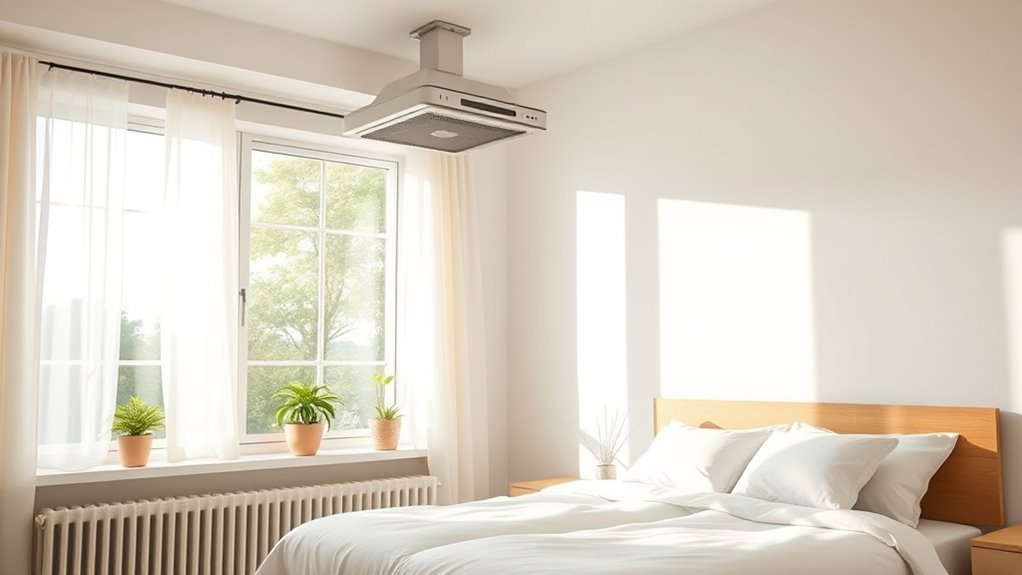
Exhaust fans are essential tools for maintaining a fresh and comfortable bedroom environment. They help improve air quality by removing excess humidity and lingering odors. To maximize their effectiveness, consider these tips:
- Use the fan consistently—turn it on during and after activities that generate moisture or strong smells to keep air fresh.
- Choose quiet models—noise control is key for restful sleep, so opt for fans designed for low noise levels.
- Position the fan properly—install it near sources of humidity, like the bathroom or closet, to efficiently vent moist air outside.
The Benefits of Air Purifiers and When to Use Them

Air purifiers can improve your bedroom air quality by removing dust, pet dander, and pollutants. Different types, like HEPA and activated carbon filters, offer specific benefits depending on your needs. Use them during sleep or when you’re home most often for the best results.
Purifier Types and Benefits
Choosing the right air purifier can considerably improve your bedroom’s air quality by removing pollutants, allergens, and odors. Understanding air purifier types helps you select the best one for your needs. For example, HEPA filters are excellent for capturing allergens and dust, while activated carbon filters excel at removing odors and chemical fumes. UV air purifiers kill bacteria and viruses, adding an extra layer of protection. The benefits of air purifiers include better sleep, reduced allergy symptoms, and cleaner air overall. Here are three key options to contemplate:
- HEPA filters for allergens and dust
- Activated carbon filters for odors
- UV purifiers for germs and bacteria
Knowing these types helps you maximize the benefits of air purifiers in your bedroom.
Optimal Usage Times
Using your air purifier at the right times can maximize its benefits and guarantee your bedroom stays fresh and healthy. For ideal air quality, turn it on during times when pollutants are likely to accumulate, such as early mornings or after cleaning. Running it during sleep helps remove allergens, dust, and airborne toxins, improving ventilation maintenance and ensuring better rest. If you live in an urban area or near busy roads, keep it on during the day to reduce pollution indoors. Also, use your purifier after airing out the room to trap any lingering particles. Consistently timing its operation supports better air quality and prolongs your device’s lifespan. Knowing when to use your air purifier is key to maintaining a healthy, comfortable bedroom environment.
Tips for Maintaining Optimal Humidity Levels

Maintaining the right humidity levels in your bedroom is essential for comfort and health. Proper humidity control improves air quality, reduces allergies, and prevents mold growth. To keep levels ideal, consider these tips:
Maintaining proper bedroom humidity enhances comfort, health, and air quality.
- Use a hygrometer to monitor humidity; aim for 40-60%.
- Use a humidifier or dehumidifier as needed to adjust air moisture.
- Ventilate regularly to refresh air quality and prevent excess humidity buildup.
Balancing humidity helps you breathe easier and sleep better. Avoid extremes, which can cause discomfort and impact your health. Keeping humidity levels in check creates a healthier, more comfortable bedroom environment.
Choosing the Right Ventilation Devices for Your Space
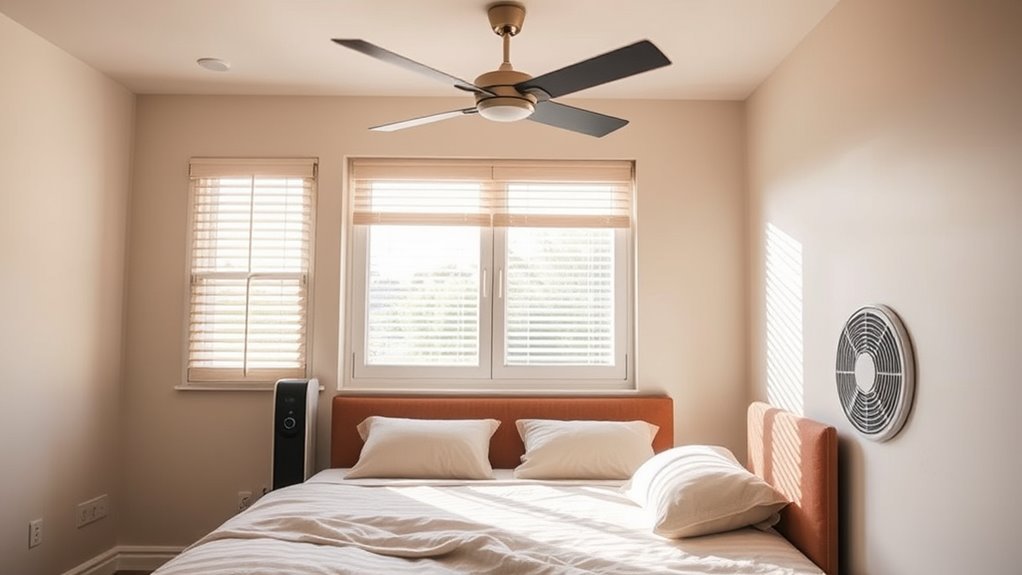
Selecting the right ventilation devices for your bedroom guarantees fresh air circulation and ideal humidity control. To improve air quality, consider different ventilation systems based on your needs. For smaller rooms, an exhaust fan can effectively remove stale air. Larger spaces may benefit from a balanced system like heat recovery ventilators (HRVs). Here’s a quick comparison:
| Ventilation Device | Best For |
|---|---|
| Exhaust Fans | Quick air removal, small rooms |
| Heat Recovery Ventilators (HRVs) | Energy-efficient, whole-room air exchange |
| Ceiling Ventilators | Continuous airflow, moderate size |
| Portable Air Purifiers | Improving air quality, specific zones |
Choose devices that match your room size and airflow needs to ensure ideal air quality and comfort.
Common Mistakes That Block Proper Ventilation

One common mistake that blocks proper ventilation is sealing off vents and air intakes, which can trap stale air inside your bedroom. This reduces air quality and can lead to stuffiness or even mold growth. Additionally, blocking vents increases the risk of noise pollution, making it harder to enjoy a peaceful space. To avoid these issues, check that vents are unobstructed and functioning properly.
Here are some mistakes to watch out for:
- Covering or sealing vents with furniture or curtains
- Using heavy drapes that block airflow
- Closing windows or doors during the day, preventing fresh air exchange
Seasonal Adjustments for Year-Round Comfort

Adapting your bedroom’s ventilation setup to seasonal changes can considerably enhance comfort throughout the year. During colder months, keep windows slightly open to improve air quality and reduce humidity, which helps prevent mold and musty odors. In warmer seasons, increase ventilation to keep fresh air circulating and prevent stuffiness. Consistent bedding maintenance, like washing sheets regularly and switching to breathable fabrics, boosts air quality and comfort no matter the season. Use fans or exhaust vents strategically to balance airflow without losing too much heat or coolness. Adjusting your ventilation practices seasonally guarantees your bedroom stays fresh, healthy, and comfortable year-round, helping you sleep better and maintain a healthier environment.
Frequently Asked Questions
Can Bedroom Plants Improve Air Quality Naturally?
Yes, bedroom plants can improve air quality naturally. They act as air purifying agents by removing toxins and increasing humidity. To maximize benefits, place plants where they get indirect sunlight and good airflow, avoiding cluttered spots. Proper plant placement guarantees they thrive and effectively clean the air, creating a healthier, more comfortable sleeping environment. Just be sure to select non-toxic varieties if you share your bed with pets or kids.
How Do Indoor Pollutants Affect Ventilation Needs?
Think of your bedroom as a busy city street; indoor pollutants are like traffic congestion, causing air exchange to slow down. When pollutants build up, your ventilation system needs to work harder to clear the air. Poor ventilation can trap allergens, dust, and chemicals, increasing health risks. To keep the air fresh, you must guarantee proper airflow and regularly refresh indoor air, preventing pollutant buildup and promoting better breathing.
Are There Eco-Friendly Ventilation Options for Bedrooms?
Yes, eco-friendly ventilation options exist for bedrooms. You can enhance air exchange naturally by opening windows regularly, especially during mild weather. Consider energy-efficient window treatments like smart blinds or breathable curtains that regulate airflow while reducing energy use. Additionally, using indoor plants can improve air quality. These eco-friendly choices promote fresh air, reduce pollutants, and support a healthier, more sustainable bedroom environment.
How Often Should Ventilation Systems Be Maintained?
You should check and maintain your ventilation system at least every 3 to 6 months. During this time, focus on filter maintenance to ensure clean, efficient airflow. Regularly replacing or cleaning filters helps optimize airflow and prevents dust buildup. Keep an eye on system performance, and if you notice reduced airflow or unusual noises, it’s time for a maintenance check. Proper upkeep guarantees comfort and promotes healthier indoor air quality.
Can Poor Ventilation Cause Long-Term Health Issues?
Poor ventilation can cause long-term health issues, and studies show that indoor air can be 2-5 times more polluted than outdoor air. When airflow is insufficient, airborne allergens and mold growth thrive, leading to respiratory problems and allergies. Over time, exposure worsens health, especially if you’re vulnerable. Keeping your bedroom well-ventilated helps reduce these risks, ensuring cleaner air and better overall wellness.
Conclusion
Good ventilation isn’t just about fresh air—it’s about creating a sanctuary where wellness thrives. When you master these tips, you’ll open a comfort level you never knew possible. But the real secret lies in understanding what your space truly needs—and that’s something only you can discover. Are you ready to take control and transform your bedroom into a gust of fresh air? The key to your best sleep and health might be closer than you think.




